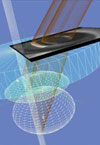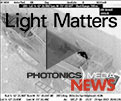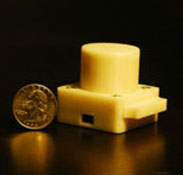 
 |
Various Factors Influence Growth of Ophthalmic Lasers
An aging population, the economy and health insurance coverage are just some of the key factors driving the use of lasers for eye surgery. Lasers are helping to advance a range of ophthalmic applications. At the same time, ophthalmology is proving an important market for manufacturers of lasers and laser-based systems. This is in no small part because of its unique blend of insurance-reimbursed (photocoagulation) and elective procedures (lasik and laser cataract surgery). Demand for elective procedures will ebb and flow with fluctuations in the economy, as it is strongly dependent on consumer confidence and how people feel about spending money from their own pocket. But changes here will be counterbalanced by demand for other, insurance-reimbursed procedures. |
|
|
|

Plasmonic Nanobubbles Speed Detection and Destruction of Cancer
A new cell-level theranostic platform detects, modifies or kills target cells while sparing normal cells with plasmonic nanobubbles. Some cancers are nearly impossible to remove without damaging important healthy organs. When such cancers appear to have a high resistance to drugs and radiation, they become practically incurable – and have a high rate of recurrence. The strategic solution would be to use a cell-level tool for detecting, modifying or killing specific cells without influencing surrounding cells and tissues. Unfortunately, modern materials and technologies cannot provide cell-specific, rapid, multifunctional processing and treatment of only the cancer cell. |
|
|
|

MicroLEDs Enabling New Generation of Fluorescence Instruments
Light sources can be customized with respect to emitter design, emission profile, beam shape and power consumption. The use of fluorescence continues to grow in life sciences applications. For analytical applications, it offers the potential for low detection levels, high specificity and minimal power consumption. In imaging applications, it offers benefits such as high signal-to-noise ratios and the ability to view dynamic processes. The availability of a range of low-cost and high-sensitivity light detectors has further accelerated the adoption of fluorescence techniques. |
|
|
|

 |
sponsored by
 |
In this edition of the industry's premier weekly newscast: bad guys can run, but they can't hide from thermal imaging; on-chip optics makes advances, a solar collector pulls in the power of 2000 suns, and a new system lets you read as you run. Hosted by Photonics Media's Laura Marshall and Melinda Rose. |
|
|

Fiber Lasers at the Cutting Edge of Surgery
Compact, lightweight and reliable, fiber lasers are taking more and more surgical procedures by storm. Femtosecond fiber lasers have emerged in the past 10 years, quickly progressing from research to development to commercialization. When compared with solid-state and gas lasers, fiber lasers offer many unique features: tremendous flexibility, convenience and reliability in surgical applications. |
|
|
|

Laser Device Images, Tracks Cells, Dye-Free
Without contrast dyes or fluorophores, a new device can image and track living cells’ reactions to various stimuli and create 3-D images of biological tissue at the nanoscale in just minutes. The system combines holographic microscopy and computational image processing to obtain 3-D images of living cells from every angle at a resolution of less than 100 nm. |
|
|
|

Implanted Fibers Stop Seizures
Optical fibers implanted in the brain can activate light-sensitive proteins that stop epileptic seizures as they are detected. The technique, developed at the University of California, Irvine, could help the more than 3 million Americans who suffer from epilepsy, a recurrent spontaneous seizure condition. |
|
|
|


PROMOTION

 |
Join Us for a Free Webinar
2013 Webinar Series - Expert Briefings
Computational Microscopy, Sensing and Diagnostics for Telemedicine and Global Health Applications
Wednesday, June 5, 2013 – 1 p.m. EDT/10 a.m. PDT
 Photonics Media will host Dr. Aydogan Ozcan, Associate Professor, Bio- and Nano-Photonics Laboratory, Electrical Engineering and Bioengineering Departments, UCLA. Dr. Ozcan will introduce new imaging and detection architectures that compensate digitally for the lack of complex optical components available in cell phones by using novel theories and algorithms to address the immediate needs of telemedicine for global health problems. Photonics Media will host Dr. Aydogan Ozcan, Associate Professor, Bio- and Nano-Photonics Laboratory, Electrical Engineering and Bioengineering Departments, UCLA. Dr. Ozcan will introduce new imaging and detection architectures that compensate digitally for the lack of complex optical components available in cell phones by using novel theories and algorithms to address the immediate needs of telemedicine for global health problems.
|
|
|




 |
Laser World of Photonics, collocated with World of Photonics Congress, is the world’s largest trade fair for lasers and laser systems in industrial manufacturing. The 21st event features three photonics forums: Lasers in Manufacturing, Biophotonics and Medical Engineering and Optical Technologies.
MORE INFO >> |
|
|
 |


Follow Photonics Media on Facebook and Twitter
|
   |
|

sponsor
 |


sponsor
 |

sponsor
 |

sponsor
 |

|